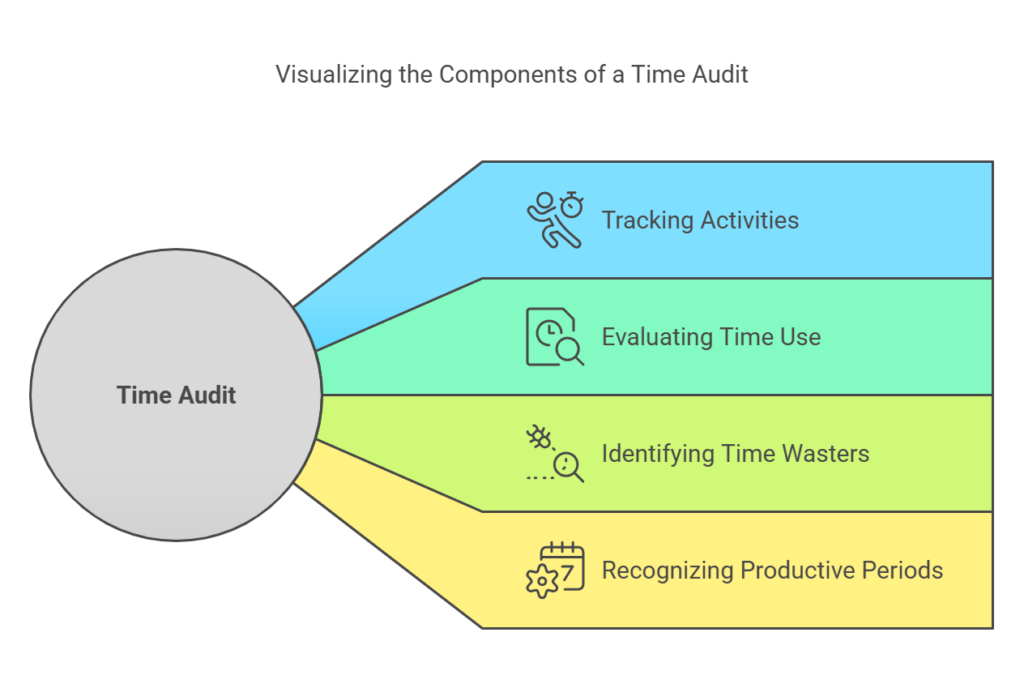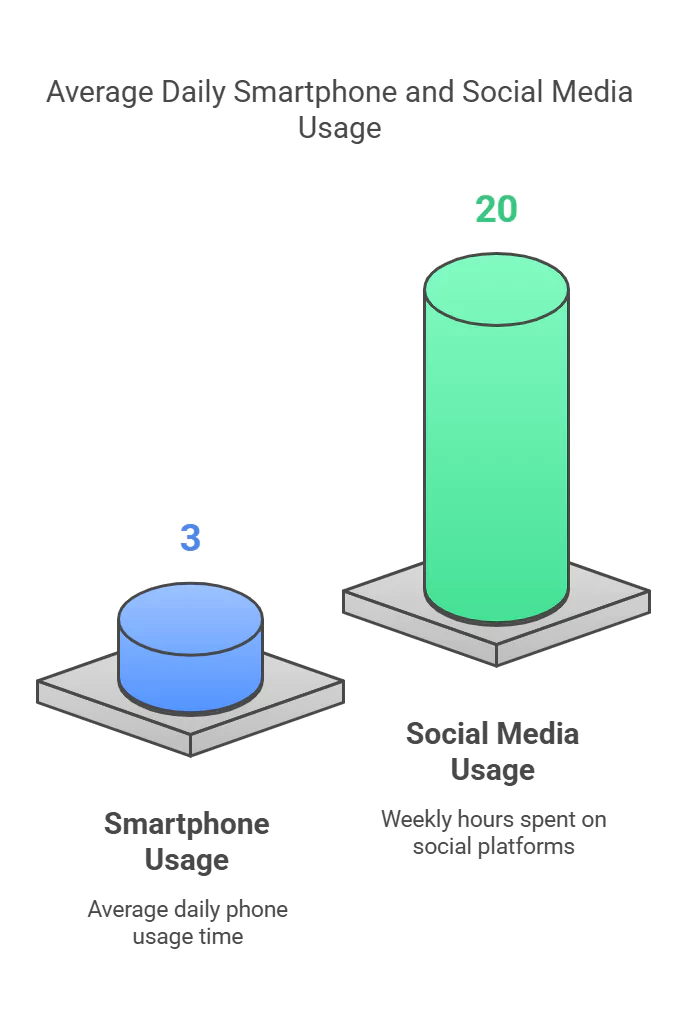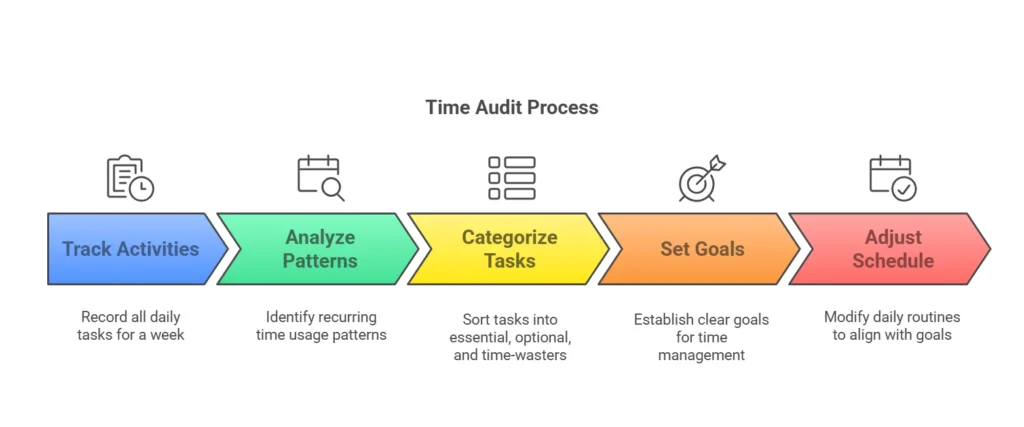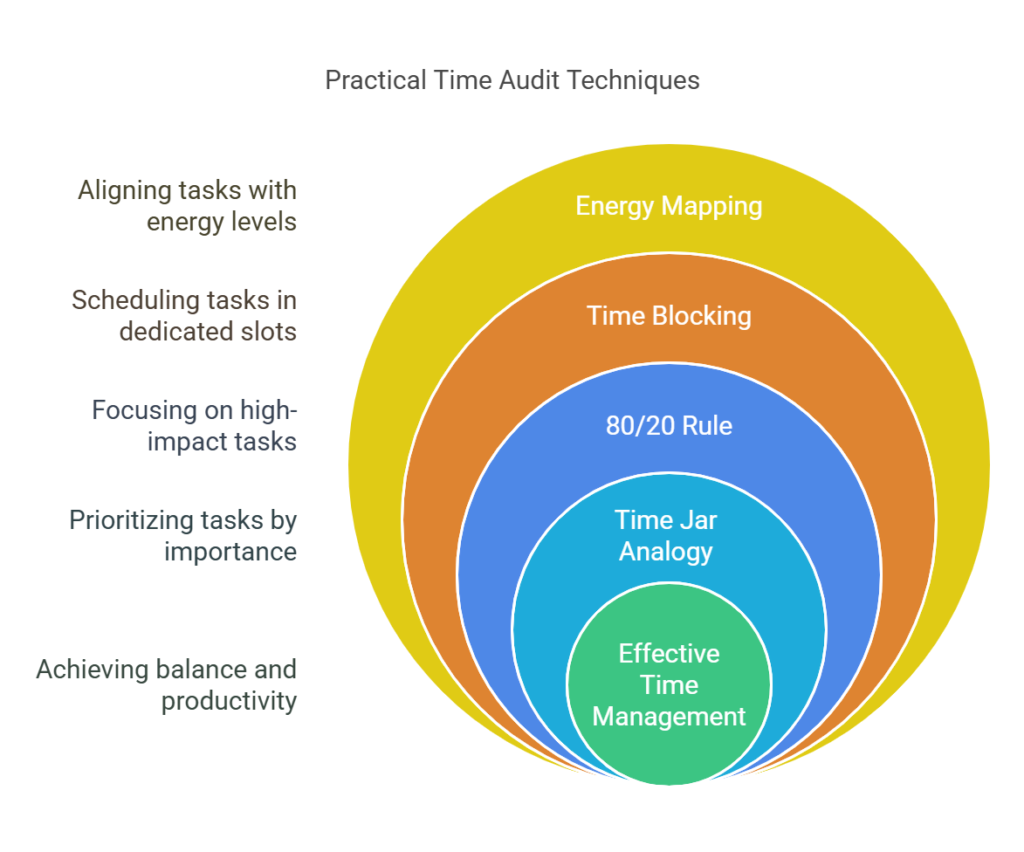A Harvard audit found wasted hours every week. The study shows that people lose 23 hours a week on tasks that add little value. Many tasks do not help our goals. This loss of time affects work and life. The study asks us to look at how we use our time. It points to many small changes that can save hours. Clear data shows where time is spent and wasted. The audit is a call to work smarter. Changing daily habits can help us use our time well. Everyone can trim wasted hours with small steps. Time matters every day.
What Is a Time Audit?
A time audit is essentially a way to track and evaluate how you spend your time. Think of it like checking your bank account but for your minutes instead of your money. You can’t budget your time if you don’t know where it’s going, right?

You know, we’re pretty bad at guessing how much time we actually spend on stuff. A study from Harvard Business Review says that top bosses spend about 23 hours a week in meetings. Many feel that a lot of that time is wasted. That adds up to over 1000 hours a year in meetings that don’t really get much done. That’s like half a workweek just gone in endless scrolling! It’s wild when you actually stop and think about it, right?

Comparing Time Use Across Industries
Time waste is not limited to one sector. Different industries show similar patterns. For example, office workers often lose time in lengthy meetings and frequent email checks. In contrast, creative professionals might spend time searching for inspiration without a clear plan.
A study from Zippia reveals that meeting-heavy jobs can waste hours each week. The research shows that time lost in meetings is a common problem across many sectors.
These comparisons suggest that many people, regardless of their job, can benefit from a time audit. When you see the common patterns, you understand that your problem is not unique. This realization can inspire a change in habits across all work fields.
Common Time Wasters
Time is lost in many common ways. Here are a few examples:
- Unfocused Meetings:
Meetings often lack a clear purpose. Studies from Harvard Business Review show that many meetings are too long and unproductive. - Frequent Email Checks:
Checking your inbox repeatedly breaks your focus. This habit wastes hours in the week. - Mindless Web Browsing:
A quick break on social media can easily turn into a long distraction. - Task Switching:
Shifting from one task to another harms concentration. It slows down progress on important work.
A survey by AMANet found that workers waste more than two hours a day on non-work activities. These examples reveal how daily actions can drain your time without you noticing.
Why Do a Time Audit?
Before we dive into the “how,” let’s talk about the “why.” Studies show that most people severely misjudge how they spend their time. Studies say the average person might lose about 2 hours a day. This happens because of too much social media, boring meetings, and other distractions. Of course, it can be more or less depending on how you work or what you do.

The scary part? We’re often unaware of these time leaks. The same study showed that 40% of people underestimated their phone use by at least an hour. A time audit exposes these blind spots, giving you the clarity to create change. Imagine realizing that cutting just 30 minutes of doom-scrolling each day could free up 15 hours a month. That’s enough time to learn a new skill, start a side hustle, or simply rest.
Harvard Data on Wasted Time
Harvard research finds that many lose up to 23 hours a week. These hours vanish through unplanned tasks and long meetings. Such wasted time reduces your chance to learn and grow. Harvard’s data challenges us to rethink our daily habits.
When you record every minute, you may be shocked. Small tasks, like checking emails or scrolling on your phone, add up quickly. Meetings without clear goals and unnecessary interruptions also steal hours. Harvard data shows these habits cost us time. Recognizing these patterns can help you take action.
The Basics of a Time Audit
A time audit might sound like a hassle, but honestly, it’s pretty simple once you get started. Here’s how you can do it without overthinking:

Step 1: Track Everything You Do for a Week
Always keep a notebook or a spreadsheet, or even a time-tracking app like Toggl or Clockify handy. Every time you switch tasks, just jot it down. And be specific! “Scrolling TikTok” is not the same as “looking up dinner recipes.” If you’re feeling extra organized (or just like playing with colors), you can even highlight different categories like work, errands, family time, or just chilling out. Simple, right?
Step 2: Look at the Big Picture
At the end of the week, go through your notes. Start spotting patterns. Are you drowning in emails but barely making progress on bigger projects? Are mornings super productive, but afternoons are a black hole of distractions? It might feel a little like checking your bank account after a shopping spree, but this is about awareness, not beating yourself up.
Step 3: Sort Your Time
Take all those tasks and sort them into three categories: “essential,” “optional,” and “time-wasters.” So, work meetings might be essential, rewatching The Office for the fifth time could be optional, and scrolling Instagram for an hour? Yeah, probably a time-waster.
Step 4: Set Some Goals
Now that you know where your time is really going, decide where you want it to go. Want to work out more? Spend more time on a hobby? Cut back on those endless social media rabbit holes? Write down a few clear, realistic goals to keep you on track.
Step 5: Make the Changes
Finally, use what you’ve learned to tweak your daily schedule. Focus on what matters most, but don’t forget to block out some downtime, too. Rest isn’t optional—it’s just as important as getting stuff done.
And that’s it! A time audit isn’t about overhauling your life overnight—it’s just about being more intentional with how you spend your hours. Simple, right?
Practical Time Audit Techniques
Alright, let’s talk about some easy, practical ways to do a time audit and actually make it work for you. Don’t worry—it’s not rocket science. These tips are simple enough to try right away.

1. The “Time Jar” Analogy
Picture your day as a jar. You’ve got big rocks (the most important stuff), pebbles (the smaller, still meaningful tasks), and sand (all the random time-wasters). If you dump in the sand first, there’s no room for the rocks. But if you start with the big rocks, the pebbles and sand can fit around them.
So, if things like exercising or spending time with family are your “big rocks,” schedule them first. Then let everything else—emails, errands, Netflix—fill the gaps. It’s all about priorities.
2. The 80/20 Rule
You’ve probably heard this one before: 80% of your results come from 20% of your efforts. In other words, figure out which tasks give you the biggest bang for your buck. For example, if most of your work success comes from just a few key clients, focus on them instead of running yourself ragged chasing every little thing.
3. Time Blocking
This one’s a game-changer. Time blocking is just a fancy way of saying “schedule your day.” Block out chunks of time for specific tasks, like 9–11 a.m. for focused work, 12–1 p.m. for lunch and emails, and 2–3 p.m. for meetings. It helps you avoid constantly jumping between tasks, which, by the way, can waste up to 40% of your productive time (thanks, University of California study).
4. Energy Mapping
Not all hours of the day are equal. Some people are morning rockstars, while others don’t hit their stride until after lunch. During your time audit, pay attention to your energy levels. If you’re sharpest at 10 a.m., save that time for high-priority stuff. If you’re always dragging around 3 p.m., that’s the perfect time for easier tasks like emails or organizing your desk.
5. The “Two-Minute Rule”
Here’s a simple trick: if something takes less than two minutes, just do it right away. Reply to that text, put your shoes away, or delete that junk email. It stops those tiny tasks from piling up and eating away at your time. When you’re doing your time audit, take note of how much time you’re losing to small stuff like hunting for your keys. Fixing those little things can save you hours in the long run.
See? None of this is complicated. It’s just about being intentional with your time and finding what works for you. Give it a shot—you might be surprised by how much more in control you feel.
The Impact of Wasted Time on Life and Work
Wasting 23 hours a week has a high cost. That time could go toward learning new skills, spending with family, or working on projects that matter. When you lose time, you lose potential. You may feel stressed, rushed, or behind.
The cost of wasted time is not just personal. Companies also lose productivity. Long, unplanned meetings and constant distractions reduce output. This affects work quality and slows down progress.
For individuals, reclaiming even a few extra hours can make a big difference. It can lead to better work outcomes and more free time. This extra time can reduce stress and help you achieve personal goals.
Expert Opinions on Time Optimization
Experts in productivity agree that time audits are eye-openers. They say that most workers are unaware of how much time they waste. When you record every task, the wasted hours become clear.
One expert from Harvard Business Review noted that reducing unnecessary meetings can boost productivity. He argued that even a 10-minute reduction per meeting can add up to hours saved each week.
A survey by AMANet found that employees often “goof off” for over two hours a day. This finding is echoed by research from MeetFox, which showed that many people waste hours on unproductive tasks.
Another expert from rep.ai explained that meetings often exceed their planned duration. He suggested that clear agendas and strict time limits can help.
These expert views underline that time optimization is not about working more but working better. By reducing wasted time, you can improve both productivity and personal well-being.
Comparing Time Audits Across Different Roles
Time audits benefit many roles. Office workers, managers, and entrepreneurs often see similar patterns. For example:
- Office Workers:
They may spend hours in unproductive meetings and frequent email checks. - Managers:
Managers often interrupt their work with unscheduled calls and meetings. This loss of focus is costly. - Entrepreneurs:
Entrepreneurs juggle many tasks. A time audit can reveal which tasks bring little value.
Data from rep.ai shows that wasted time in meetings is a common issue across roles. Even if your job is different, the core idea remains: track your day, find waste, and make changes.
How to Maintain a Time-Optimized Daily Routine
The work does not stop after one time audit. Maintaining an optimized routine requires continuous effort. Here are tips for long-term success:
- Conduct Regular Audits:
Check your routine every month. This helps you stay aware of wasted time. - Set Weekly Goals:
Choose a small improvement goal each week. For example, cut email time by 15 minutes. - Use Digital Tools:
Keep using time tracking apps and digital planners. Consistent tracking builds better habits. - Stay Flexible:
Your schedule may change. Regular reviews allow you to adjust your plan. - Celebrate Small Wins:
Recognize improvements. Small gains add up over time.
These practices help you stick with your new routine. They ensure that you continue to reclaim time week after week.
Tools for Time Audits
Several tools can help you conduct a time audit. Many free apps offer easy tracking. Here are a few options:
- Time Tracking Apps:
Apps like Toggl and Clockify help you record your activities. They make it simple to see where your hours go. - Daily Journals:
A notebook or digital journal works well. Writing tasks down helps you recall details later. - Calendar Blocking:
Use your digital calendar to set aside blocks for tasks. This method makes your day structured and clear.
Choose a tool that fits your routine. The key is to track every activity for at least a week. This will give you a full picture of your habits.
Wrapping It Up
Time audits show that many people waste up to 23 hours each week. Harvard data and industry research reveal that small tasks and unproductive meetings steal precious time. By tracking your daily habits, you can identify waste and take steps to reclaim lost hours.
Simple changes, such as setting clear goals, limiting distractions, and improving meeting efficiency, can save you many hours. These extra hours can boost productivity, lower stress, and improve your work-life balance.
Regular time audits and constant reviews ensure you stay on track. Even minor adjustments can lead to big gains over time. The key is to remain aware of how you spend your time and make deliberate changes that bring value.
FAQs
How long should I track my time?
A week’s great if you want the full picture, but honestly, even 2–3 days can give you plenty of insight. Don’t overthink it—just start.
What if I forget to track some activities?
It happens! Set reminders or use apps to help you stay on top of it. And if you miss something, don’t stress—just make your best guess instead of skipping it altogether.
Can a time audit help with long-term goals?
Absolutely. It shows how much time you’re actually putting into your goals and helps you figure out where to focus more—or less.
How do I avoid feeling overwhelmed?
Keep it simple. Use whatever tools feel easiest, and don’t sweat the small stuff. Focus on the bigger trends instead of nitpicking every little detail.
Can a time audit improve work-life balance?
For sure. It shows where your time’s going, so you can adjust and make more room for what really matters—whether that’s work, downtime, or quality time with loved ones.
Study & References
- https://hbr.org/2017/07/stop-the-meeting-madness
- https://www.amanet.org/articles/new-survey-shows-times-a-wastin-workers-goof-off-more-than-two-hours-a-day/
- https://meetfox.com/en/blog/how-much-time-do-you-actually-waste-in-a-day
- https://rep.ai/blog/time-wasted-in-meetings
- https://www.zippia.com/advice/meeting-statistics/







